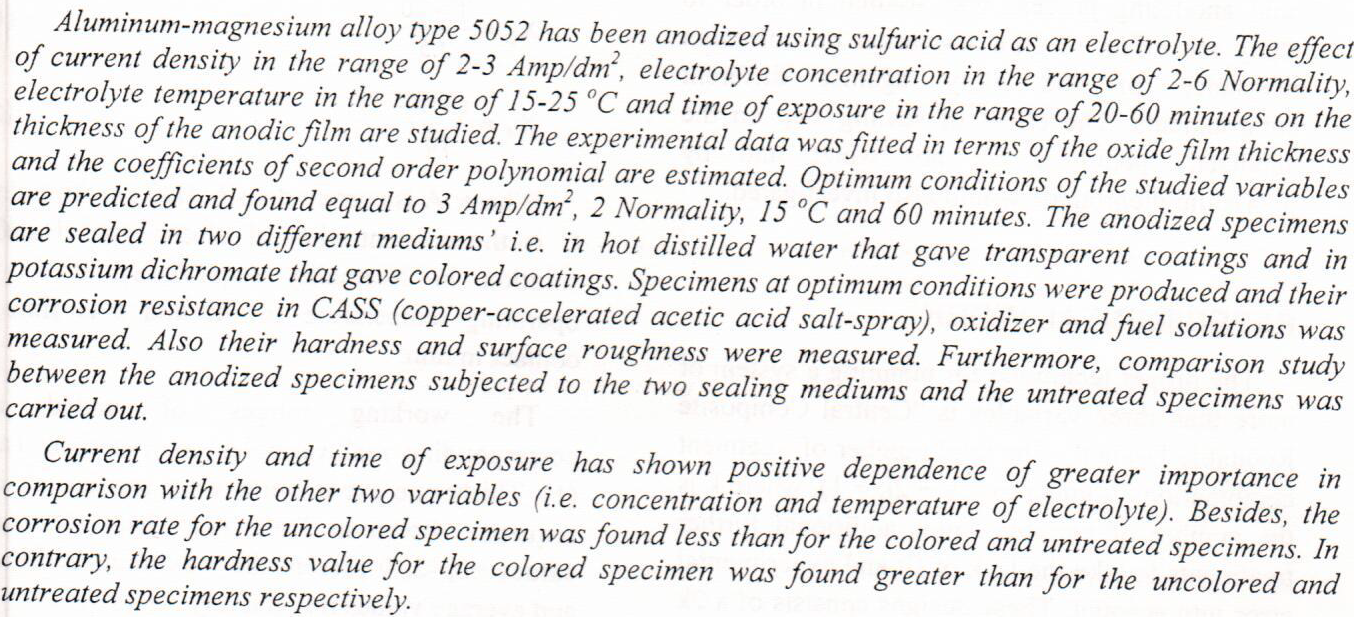
The extraction of iron from aqueous chloride media in presence of aluminum was studied at different kinds of extractants(cyclohexanone, tributyl phosphate, diethyl ketone), different values of normality (pH of the feed solution), agitation time, agitation speed, operating temperature, phase ratio (O/A), iron concentration in the feed, and extractant concentration]. The stripping of iron from organic solutions was also studied at different values of normality (pH of the strip solution) and phase ratio (A/O). Atomic absorption spectrophotometer was used to measure the concentration of iron and aluminum in the aqueous phase throughout the experiments.The best values of extraction coefficient and stripping coefficient are obtained under the
... Show MoreAn experimental investigation has been carried out for zinc-nickel (Zn-Ni) electro-deposition using the constant applied current technique. Weight difference approach method was used to determine the cathode current efficiency and deposit thickness. Also, the influence effect of current density on the deposition process, solderability, and porosity of the plating layer in microelectronic applications were examined. The bath temperature effect on nickel composition and the form of the contract was studied using Scanning Electron Microscope (SEM). Moreover, elemental nature of the deposition was analyzed by Energy Dispersive X-Ray (EDX).
It has been found that the best bath temperature
... Show MoreBackground Alloys with the addition of zirconium and niobium eliminate the adverse effects of aluminum and vanadium on the nervous system, the possibility of metallosis and the initiation of diseases (including cancers or Alzheimer›s disease). In addition, they have better corrosion resistance, and a Young›s modulus value similar to longitudinal bone tissue. Therefore, only choosing appropriate materials does not guarantee proper functioning of the implants, the surfaces of the implants also have to be suitable to meet the requirements. The laser surface hardening process modifies the surface properties by imparting microstructural changes, whereas surface remelting induces changes in the surface topography, roughness, wettability and w
... Show MoreThis research was to determine the effect of rare earth metal (REM) on the as-cast microstructure of Mg-4Al alloy. The rare earth metal used here is Lanthanum to produce Mg-4Al-1.5La alloy. The microstructure was characterized by optical microscopy. The phases of this alloy were identified by X-ray diffraction. The microstructure of Mg-4Al consists of α-Mg and grain boundaries with precipitated phase particles. With the addition of Lanthanum, three distinct phases were identified in the X-ray diffraction patterns of the as cast Mg-4Al-1.5La: Mg, Al11La3, Al4La. The Mg17Al12 phase was not detected. The addition of Lanthanium increases the hardness and dec
... Show MoreThe present research had dealt with preparing bars with the length of about (13 cm) and adiametar of (1.5 cm) of composite materials with metal matrix represented by (Al-Cu-Mg) alloy cast enforced by (ZrO2) particles with chosen weight percentages (1.5, 2.5 ,3.5, 5.5 %). The base cast and the composite materials were prepared by casting method by uses vortex Technique inorder to fix up (ZrO2) particles in homogeneous way on the base cast. In addition to that, two main groups of composite materials were prepared depending on the particles size of (ZrO2) , respectively. &n
... Show MoreThis research includes a study of dezincification by corrosion from brass alloys in three types of media, which are acidic solution, basic and slat solution in different percentages. The study show the higher dezincification occurs in basic solution which decrease the fatigue properties where the fatigue properties are inversely proportional with dezincification.
Large quantities of contaminated carwash wastewater are produced per day from carwash places. Extensively it contains large quantities of chemicals from detergents, oil, grease, heavy metals, suspended solids, types of hydrocarbons, and biological contents. A novel electrocoagulation treatment by foil electrodes was conducted to remove COD, turbidity, Total Dissolved Solids (TDS) from contaminated carwash wastewater and decrease its Electrical Conductivity (EC). A thin layer of aluminum foil is used as an electrode in this treatment process. The effects of different voltage and treatment times were studied. The best result was found at a voltage of 30 volts and treatment time 90 minute where the removal efficiency of COD
... Show More (8)
(8)
In this study an experimental work was done to study the possibility of using aluminum rubbish material as a coagulant to remove the colloidal particles from oily wastewater by dissolving this rubbish in sodium hydroxide solution. The experiments were carried out on simulated oily wastewater that was prepared at different oil concentrations and hardness levels (50, 250, 500, and 1000) ppm oil for (2000, 2500, 3000, and 3500) ppm CaCo3 respectively. The initial turbidity values were (203, 290, 770, and 1306) NTU, while the minimum values of turbidity that have been gained from the experiments in NTU units were (1.67, 1.95, 2.10, and 4.01) at best sodium aluminate dosages in milliliters (12, 20, 24, and 28) for
... Show MoreNuclear structure of 29-34Mg isotopes toward neutron dripline have been investigated using shell model with Skyrme-Hartree–Fock calculations. In particular nuclear densities for proton, neutron, mass and charge densities with their corresponding rms radii, neutron skin thicknesses and inelastic electron scattering form factors are calculated for positive low-lying states. The deduced results are discussed for the transverse form factor and compared with the available experimental data. It has been confirmed that the combining shell model with Hartree-Fock mean field method with Skyrme interaction can accommodate very well the nuclear excitation properties and can reach a highly descriptive and predictive power when investiga
... Show MoreThe corrosion behavior of bare and chemical conversion coated (through anodizing) aluminum ASA 606 I in stagnant chromic acid solutions . Solutions of 2, 6 & J O wt. % Cr03 at 45°C, have been investigated using polarization technique. The anodizing experiments were conducted under fixed conditions of 35 minute exposure time and 30 volt supplied voltage. The most important feature achieved was the great difference in behavior between the anodic polarization curves for bare and anodized aluminum in different concentrations of chromic acid solutions.
